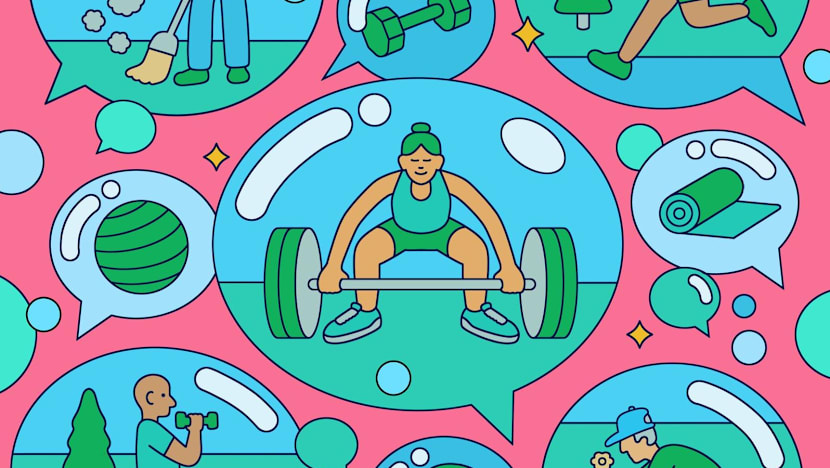Health
Six Daily Habits to Prevent Injuries and Stay Active

Injuries often arise from either excessive activity or prolonged inactivity, leading many individuals to seek help from physical therapists. According to experts, such as John Gallucci Jr., a physical therapist based in New Jersey, understanding the balance between movement and rest is crucial to maintaining a pain-free lifestyle.
Many people rush into intense physical activities without adequate preparation. For instance, a sudden weekend of tennis might lead to hip pain, just as countless hours spent seated can also trigger discomfort. To combat these issues, physical therapists recommend integrating specific daily habits into routines that promote longevity and well-being.
Prioritize Regular Checkups with a Physical Therapist
Most individuals tend to visit a physical therapist only when pain becomes unbearable. Amy Kimball, a physical therapist and assistant professor at the University of Iowa, advocates for annual checkups to evaluate physical health and receive tailored advice. Depending on your insurance, a referral might not be necessary, allowing proactive evaluations before injuries occur. For example, if someone aims to run a 5K, a physical therapist can assess their stride or design a suitable strength training program. Heather McGill, a physical therapist in San Francisco, emphasizes that therapy plans should evolve as physical capabilities change. “If you’re still doing the same five exercises that you were doing five years ago, something’s not working,” she noted.
Moderate High-Intensity Interval Training
High-Intensity Interval Training (HIIT) has surged in popularity, but overdoing it can lead to injuries and burnout. Julia Rosenthal, a physical therapist and orthopaedic specialist in New York City, cautions against participating in boot camp sessions excessively. “You’re persistently stressing out your nervous system without any ability to recover,” she explained. She suggests limiting high-intensity workouts to a few times a week to allow the body adequate recovery time.
Gradually Increase Activity Levels
Transitioning into new sports or exercise programs requires a thoughtful approach. Alyssa Skala, a professor of physical therapy and orthopaedic surgery at Wash U Medicine in St Louis, has observed many injuries stemming from sudden activity, such as Achilles tendon ruptures during an intense basketball game after a sedentary period. She advises starting any new regime slowly and increasing intensity by no more than 10 percent per week. This gradual approach helps muscles, joints, and flexibility adjust effectively.
Enhance Coordination with Your Non-Dominant Hand
Using your non-dominant hand for daily tasks can lead to better coordination and reduce the risk of injury. Heather McGill recommends this practice, especially for individuals who frequently experience wrist or elbow pain, such as golfers. By engaging the less dominant side, you can help distribute the physical demands placed on your stronger hand.
Reframe Household Chores as Workouts
Many people overlook the physical demands of household chores, often leading to injuries. John Gallucci Jr. has noticed a spike in cases of hamstring and Achilles strains during seasonal tasks, such as cleaning gutters or planting flowers. He suggests treating chores similarly to a gym workout by breaking them into smaller sessions over several days. This method allows for gradual adaptation to physical demands, helping to prevent overexertion.
Understand the Limitations of Stretching
While stretching is often seen as a remedy for tight muscles, it may not always address the underlying issues. Julia Rosenthal warns that overemphasis on stretching can sometimes lead to more tightness. Dynamic warm-ups before exercise are frequently recommended over static stretching. For those experiencing persistent tightness, consulting a physical therapist might be more beneficial than relying solely on stretches. Strength training can also help alleviate discomfort caused by muscle guarding around injuries.
Incorporating these six daily habits can significantly reduce the likelihood of injuries while enhancing overall physical health. Emphasizing the importance of balanced activity and regular assessments can empower individuals to maintain an active and injury-free lifestyle.
-

 Business5 months ago
Business5 months agoKenvue Dismisses CEO Thibaut Mongon as Strategic Review Advances
-

 Lifestyle4 months ago
Lifestyle4 months agoHumanism Camp Engages 250 Youths in Summer Fest 2025
-

 Sports4 months ago
Sports4 months agoDe Minaur Triumphs at Washington Open After Thrilling Comeback
-

 Sports5 months ago
Sports5 months agoTupou and Daugunu Join First Nations Squad for Lions Clash
-

 Top Stories5 months ago
Top Stories5 months agoColombian Senator Miguel Uribe Shows Signs of Recovery After Attack
-

 World5 months ago
World5 months agoASEAN Gears Up for Historic Joint Meeting of Foreign and Economic Ministers
-

 Health4 months ago
Health4 months agoNew Study Challenges Assumptions About Aging and Inflammation
-

 Business5 months ago
Business5 months agoOil Prices Surge Following New EU Sanctions on Russia
-

 Entertainment4 months ago
Entertainment4 months agoDetaşe-Sabah Violin Ensemble Captivates at Gabala Music Festival
-

 Entertainment4 months ago
Entertainment4 months agoBaku Metro Extends Hours for Justin Timberlake Concert
-

 Top Stories5 months ago
Top Stories5 months agoRethinking Singapore’s F&B Regulations Amid Business Closures
-

 Business5 months ago
Business5 months agoU.S. House Approves Stablecoin Bill, Sends to Trump for Signature









